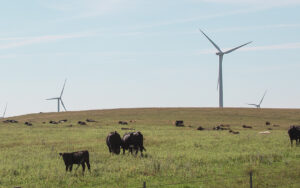New Ulm benefits from increased demand for renewable energy
September 8, 2021Heartland facilitates sales of excess RECs
The electric grid is complex.
When electricity is generated, whether it be from coal, natural gas, wind, or solar, it flows where it’s needed. The grid can’t distinguish the source or direct it to go to a certain location.
Utilities in Minnesota are required to generate or procure 25% of their total retail electric sales from renewable sources by the year 2025.
Since utilities can’t control where power flows on the grid, a special system had to be created to identify and claim renewable sources of power.
Renewable Energy Credits, or RECs, are proof that electricity was generated by a renewable energy source and delivered to the electric grid.
New Ulm Public Utilities recently worked with their wholesale power supplier, Heartland Consumers Power District, to sell excess RECs, providing a financial boost to the utility of over $300,000.
How do RECs work?
Each time one megawatt-hour of electricity is generated from a renewable resource such as wind, one REC is created.
If you own the renewable energy source, you own the REC generated. It is your choice to claim the credit or sell it. Claiming the credit also retires the credit and shows proof of utilizing renewable energy.
The Midwest Renewable Energy Tracking System (M-RETs) tracks renewable energy generation and assists in verifying compliance with renewable portfolio standards, such as Minnesota’s.
M-RETS creates a renewable energy certificate for every MWh of renewable energy produced in the region. The system is used to verify, manage and trade RECs.
Once a REC is retired, it cannot be used again. RECs are uniquely numbered and include information such as where they were generated, the type of renewable resource they came from and a date stamp of generation. This is done to prevent the double-counting of renewable generation.
By purchasing RECs, the owner has certified proof of using renewable energy without having to install a renewable system on their home or business. Purchasing RECs also supports the renewable energy market. RECs are tradable, non-tangible commodities.
Increased demand drives up prices
New Ulm Public Utilities acquires RECs through their wholesale power supplier, Heartland Consumers Power District. Heartland’s resource mix includes wind energy from the Wessington Springs Wind Energy Center, a 34 turbine, 51 MW wind farm in Jerauld County, SD.

New Ulm currently receives 5.5 MW of wind energy around the clock from Heartland. Of the 167,000 MWh of energy New Ulm purchases from Heartland, about 29%, or 48,000 MWh is from wind energy.
Therefore, New Ulm acquires 48,000 RECs each year.
Heartland helps administer New Ulm’s RECs through M-RETs. Data from the wind farm is submitted by a third-party so RECs can be created based on energy generated. Heartland maintains a separate New Ulm holding account under Heartland’s M-RETS account to keep track of their quantity of RECs and the year each was created. Heartland is then able to retire RECs on behalf of New Ulm.
Demand for RECs has risen dramatically over the past year, pushing REC prices higher. Heartland approached New Ulm about selling excess RECs because of the higher prices.
Because New Ulm purchases more wind energy than necessary to meet the state standard, Heartland marketed New Ulm’s surplus RECs and sold them for a net price of $5.04 each, totaling over $317,000.
“Heartland continuously monitors the REC market,” said Heartland Chief Operations Officer Nate Jones. “Like any market, the recent increase in demand for RECs has driven the price up. That proved beneficial as New Ulm had excess certificates to sell. We are happy to provide this service on their behalf.”
